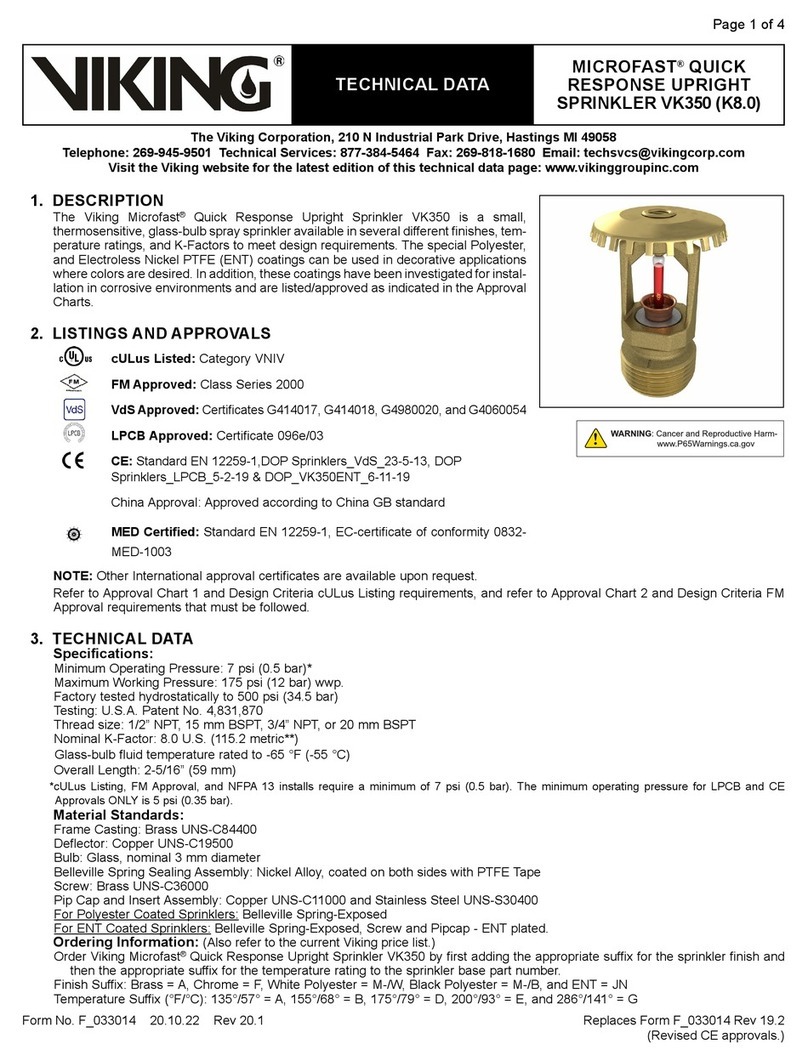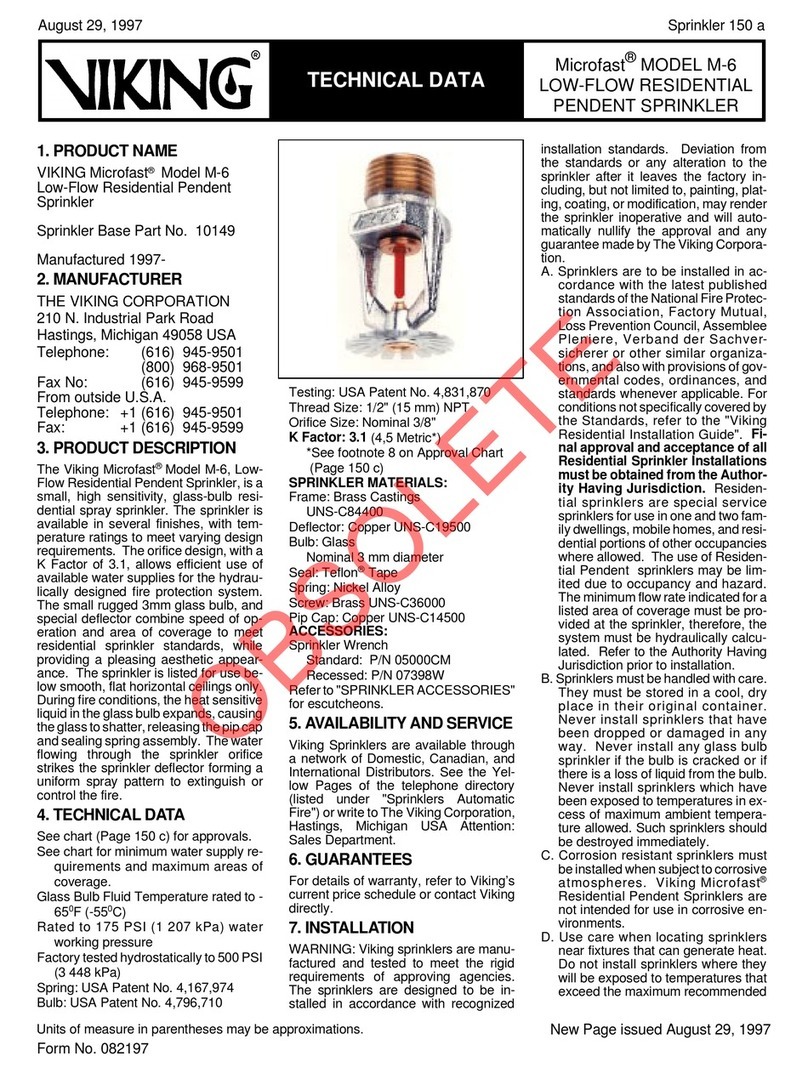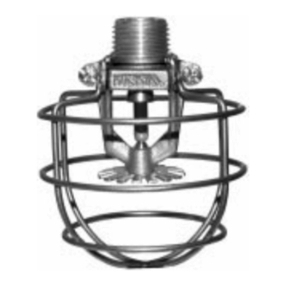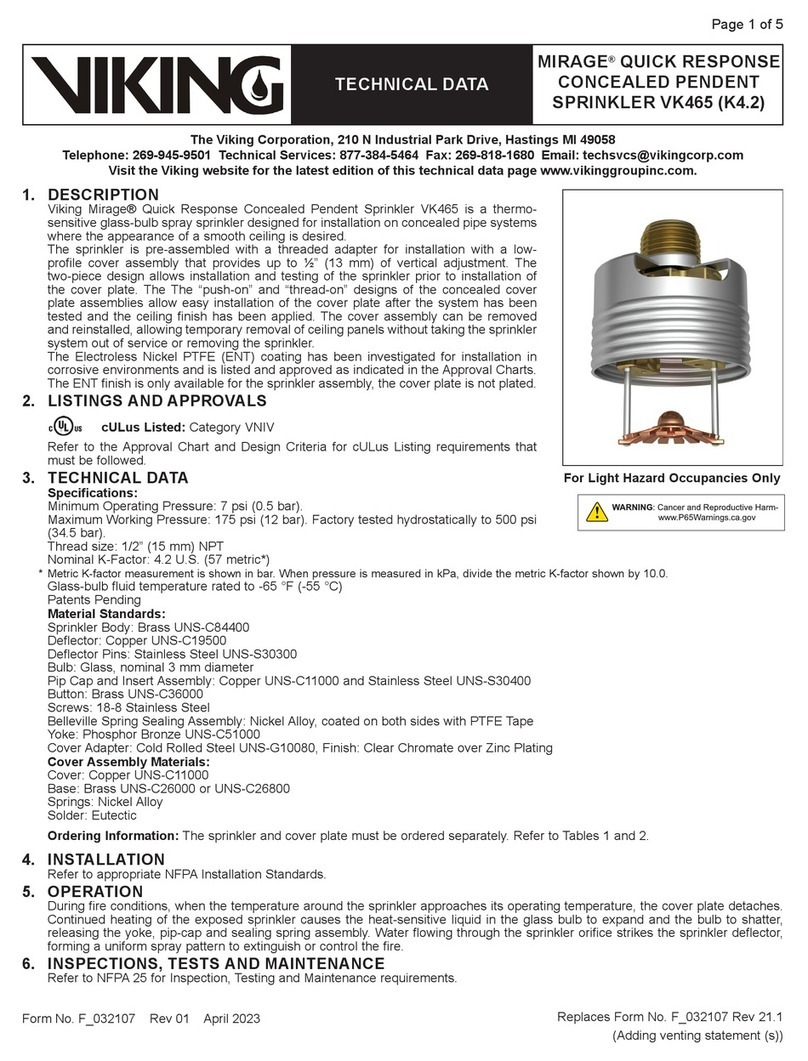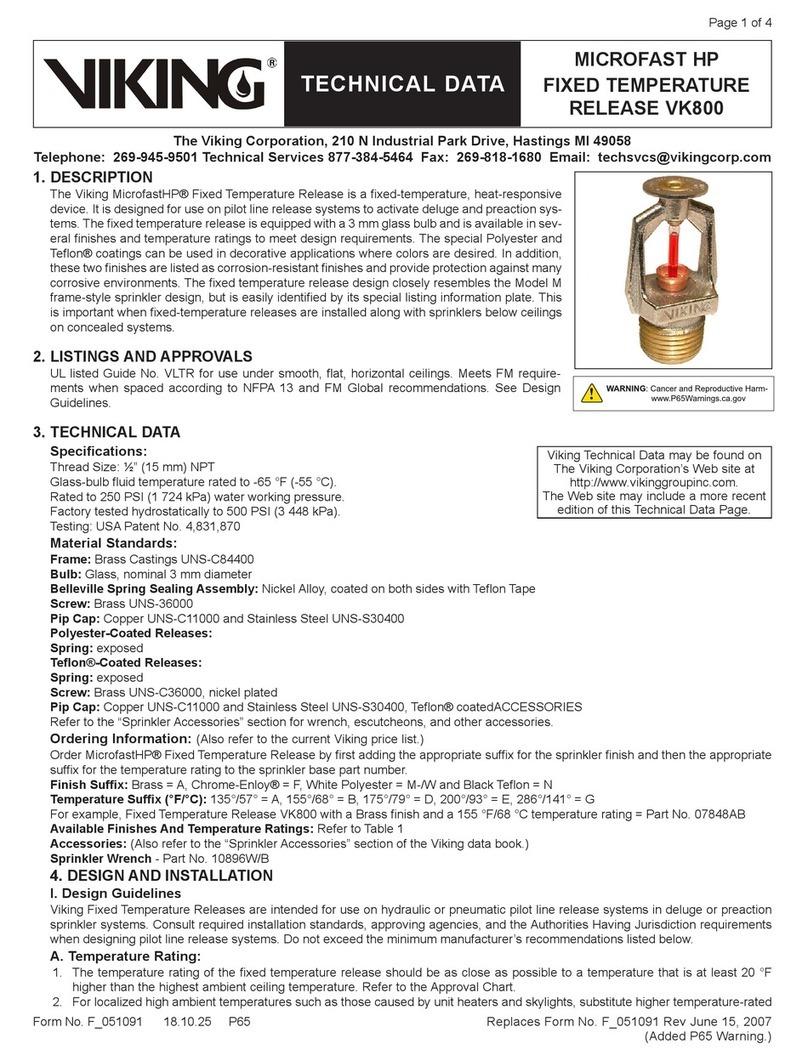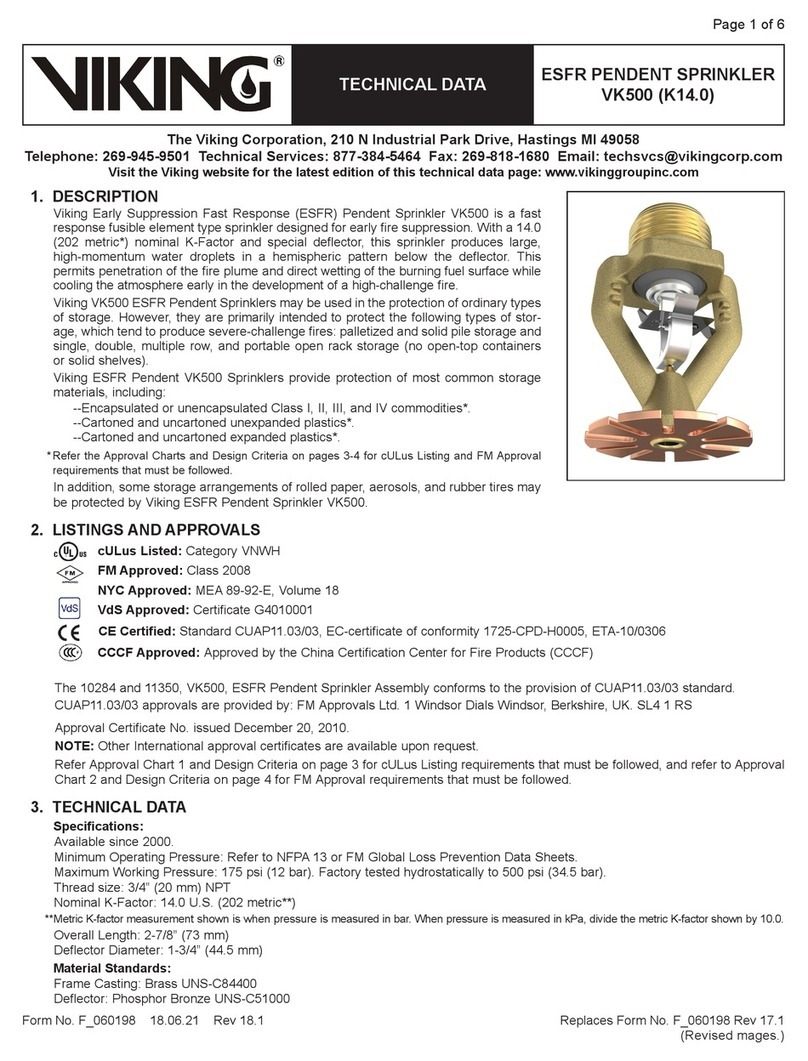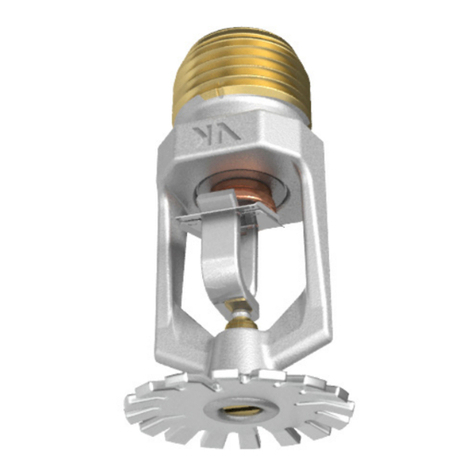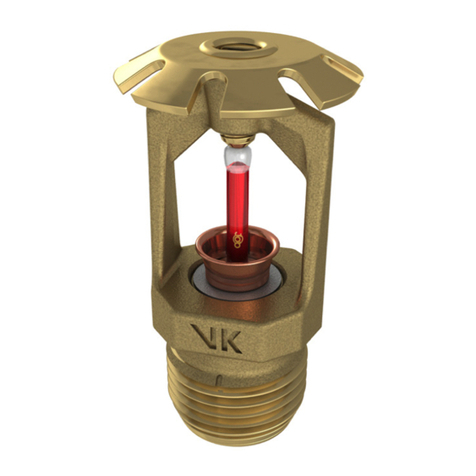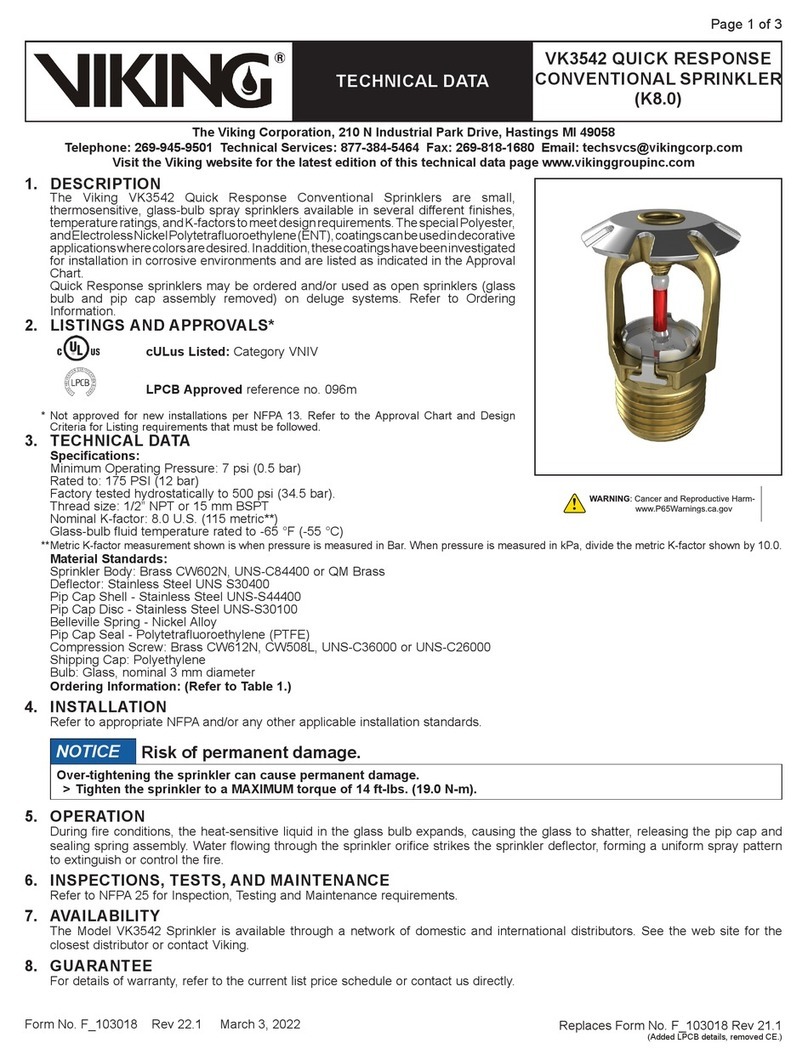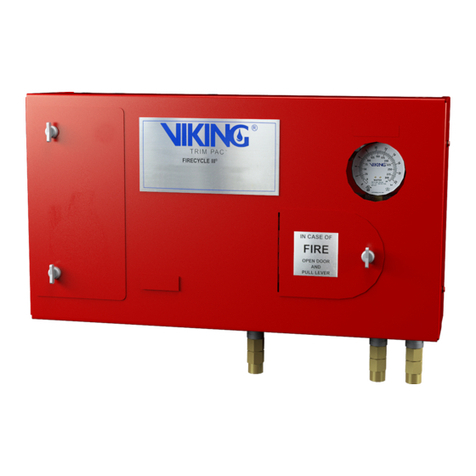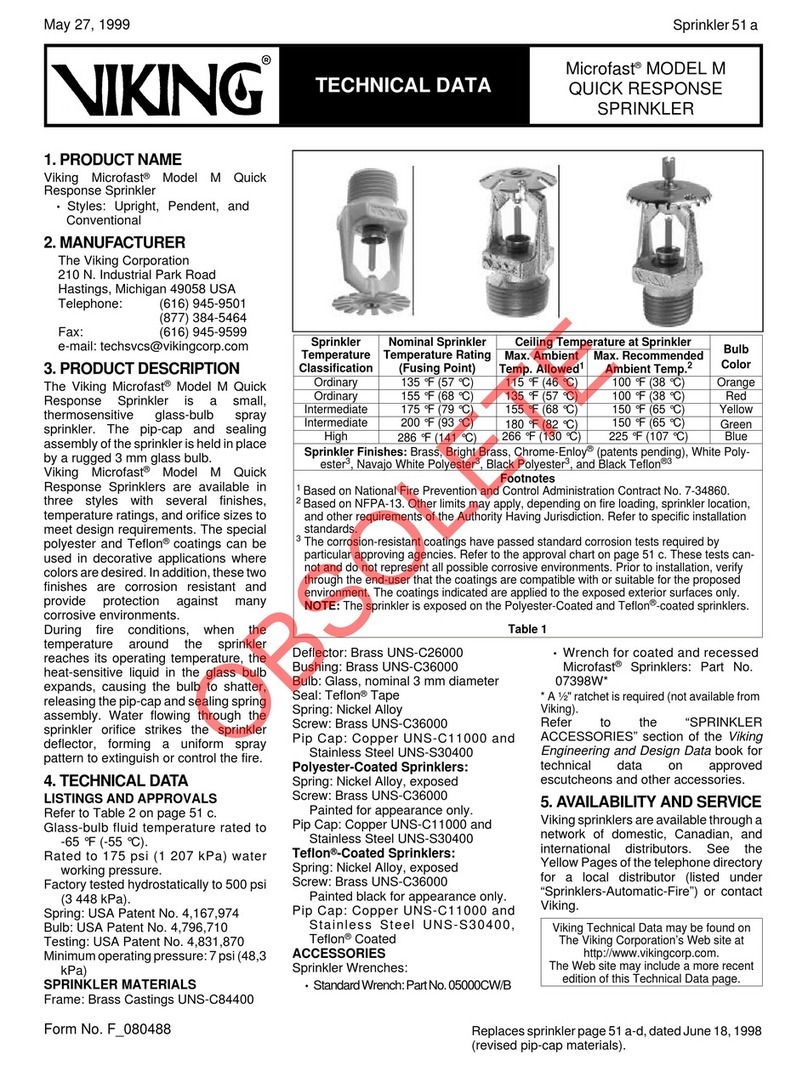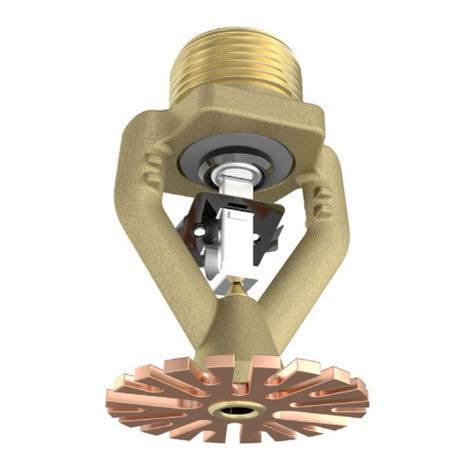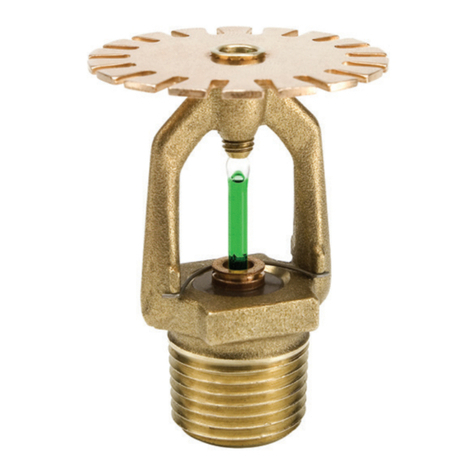
chanical damage. Viking Institutional
Style Quick Response Flush Hori-
zontal Sidewall Sprinklers must be
installed below smooth, flat, horizon-
tal ceilings. The sprinklers must be
installed with the deflectors located
4" to 12" (102 mm to 304 mm) below
the ceiling, and flush with the wall in
which they are installed.
Always install horizontal sidewall
sprinklers with the top of the deflector
oriented parallel with the ceiling. The
wrench ear on the top of the Viking
Institutional Style Quick Response
Flush Horizontal Sidewall Sprinkler
is marked with the word “top”.
Before installing, be sure to have the
appropriate sprinkler model and
style, with the correct orifice size,
temperature rating, and response
characteristics. Install the sprinklers
accordingto thefollowingsequence:
1. Install all piping and cut the sprin-
kler nipple so that the ½" (15 mm)
NPT outlet of the reducing cou-
pling is at the desired location and
centered in a 2-1/4" (57,22 mm)
diameter opening in the wall (due
to the lockring).
Note: If the retaining flange as
-
sembly is to be used, slide the
flange over the sprinkler nipple
prior to threading the nipple into
the tee, as shown in Figure 3A.
2.The internal diameterof thespecial
Flush/Concealed Sprinkler Wrench
is designed for use with the sprin-
kler contained in the protective
plastic shell. With the sprinkler in
the shell, apply a small amount of
pipe-joint compound or tape to the
external threads of the sprinkler
only, taking care not to allow a
build-up of compound in the sprin-
kler inlet.
3. Refer to Figure 3B and use only
the special Flush/Concealed
Sprinkler Wrench, which is de-
signed for installing Viking Institu-
tional Style Quick Response
Flush Horizontal Sidewall Sprin-
klers. With the sprinkler in the
plastic protective shell, place the
unit into the wrench. DO NOT use
the fusible link to start or thread
the sprinkler into a fitting. Turn the
unit clockwise to thread the sprin-
kler into the coupling, taking care
not to over-tighten or damage the
sprinkler operating parts.
G. After installation, the entire sprinkler
system must be tested. The test must
be conducted to comply with the in-
stallation standards.
Make sure the sprinkler has been
properly tightened. If a thread leak
occurs, normally the sprinkler must
be removed, new pipe-joint com-
pound or tape applied, and then rein
-
stalled. This is due to the fact that
when the joint seal is damaged, the
sealing compound or tape is washed
out of the joint.
H. After testing, repairing all leaks, and
installing and painting the wall, re
-
move the plasticprotective shell from
the sprinkler.
INSTALLATION TIP: Do not install the
lockring onto the sprinkler until after the
sprinkler nipple has been cut back to en-
sure desired placement of the sprinkler
in relation to the outer surface of the
wall. The lockring will prove difficult to
remove from the sprinkler once it has
been installed behind the face of the
wall. Check finished product by tempo-
rarily installing the escutcheon plate
onto the sprinkler without the lockring,
using the Institutional Escutcheon In
-
stallation Wrench. If necessary, re-cut
the sprinkler nipple as required.
Once satisfied with sprinkler location
compared to the front of the wall, install
the lockring and the escutcheon plate
following steps I through K on this page.
The escutcheon plate cannot be re-
moved after it has been installed with
the lockring, so do not install the es-
cutcheon plate with the lockring until af-
ter the system has been tested.
I. As shown in Figures 3C and 3D, fit the
lockring over the open end of the pro-
tective sprinkler shell and use the
shell to gently press the lockring over
the threads of the sprinkler. The ring
must rest against the two wrench
ears of the sprinkler body with the
four arms of the lockring pointing out-
ward.
J. REMOVE THE PLASTIC PROTEC-
TIVE SHELL from the sprinkler.
(Recommendation: retain a protec
-
tive shell in the spare sprinkler cabi
-
net.)
K. As depicted in Figure 3E, use the In-
stitutional Escutcheon Installation
Wrench to screw on the escutcheon
plate clockwise. The face of the es
-
cutcheon plate is equipped with four
indentations to complement the de-
sign of the Institutional Escutcheon
Installation Wrench and facilitate in-
stallation of the escutcheon plate.
As the escutcheon plate is threaded
onto the sprinkler body, the four arms
of the lockring must fully engage with
the radialgrooves onthe inside of the
escutcheon plate. Continueto thread
the escutcheon plate onto the sprin-
kler body until the plate’s flange fits
tightly against the surface of the wall.
Then, proceed to turn the escutch
-
eon plate another ½ turn clockwiseto
ensure that it is secured to the wall.
The arms of the lockring are angled
and designed to wedge into the
coined radial grooves on the inside
face of the escutcheon plate to keep
the escutcheon plate from being un-
screwed. Thus, an attempt to remove
the escutcheon plate is prevented af-
ter it is installed with the lockring. DO
NOT MODIFY THE UNIT.
L. The retaining flange, located behind
the wall, must fit snug against the in
-
ner surface of the wall to prevent ver-
tical movement of the assembly. Use
a 1/8" hex wrench to tighten the re-
taining flange screw and secure the
assembly into place to prevent it from
being pulled through the wall.
M. DISASSEMBLY: Refer to section 9.
MAINTENANCE, paragraph D. and
follow all warnings and instructions.
9. MAINTENANCE
(Refer to Figures 1, 2, and 3.)
NOTICE: The owner is responsible for
maintaining the fire protection system
and devices in proper operating condi-
tion. For minimum maintenance and in
-
spection requirements, refer to the ap-
propriate National Fire Protection Asso
-
ciationstandardthatdescribes care and
maintenance of sprinkler systems. In
addition, the Authority Having Jurisdic-
tion may have additional maintenance
requirements that must be followed.
A. The sprinklers must be inspected on
a regular basis for corrosion, me-
chanical damage, obstructions,
paint, etc. The frequency of inspec
-
tions may vary due to corrosive at
-
mospheres, water supplies, and ac-
tivity around the device.
B. Sprinklers that have been painted or
mechanically damaged must be re-
placed immediately. Sprinklers
showing signs of corrosion shall be
tested and/or replaced immediately
as required. Installation standards
require sprinklers to be tested and, if
necessary,replaced after a specified
term of service. Refer to the installa
-
tion standards (e.g., NFPA 25) and
the Authority Having Jurisdiction for
the specified period of time after
which testing and/or replacement is
required. Sprinklers that have oper-
ated cannot be reassembled or re
-
used, but must be replaced. When
replacing sprinklers, use only new
sprinklers.
C. The sprinkler discharge pattern is
critical for proper fire protection.
Nothing should be hung from the
sprinkler, attached to it, or otherwise
obstruct the discharge pattern. All
obstructions must be immediately re-
moved or, if necessary, additional
sprinklers installed.
D. When replacing existing sprinklers,
the system must be removed from
service. Refer to the appropriate
Sprinkler 126 n
TECHNICAL DATA INSTITUTIONAL STYLE
QUICK RESPONSE FLUSH
SIDEWALL SPRINKLER
August 29, 2003

